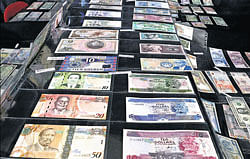
Mauritania, Djibouti, Swaziland, Kyrgiztan, Eritrea, Zaire, De Guinee, Estonia, Gambia, Comoros, Samoa, Tonga, Aruba, the list continues... Sounds strange?
Trying to guess who or what are they? These are names of some of the countries in the world.
Richard Lobo, a native of Karkala, resident of Kadri and a member of Dakshina Kannada Philatelic and Numismatic Association (DKPNA), has currencies of 220 countries including the above mentioned countries — most of which are unheard by many. Interestingly, all the 1,100 currencies in possession of Lobo are brand new currencies and most of them are as crisp as new bundle of notes.
It is a wellknown fact that just like the stamps give details about a particular country, many currencies too tell the story of different nations. Some of the collections of Lobo are so fascinating that you will be carried away. Nearly 700 out of 1,100 currencies were on display at Head Post Office on Sunday, as a part of DKPNA’s monthly exhibition.
Rare collections
Some of the rare collections of Lobo include a 100-year-old German currency (dated April 21, 1910) with a face value of 1,000 Franc. Germany was united then. It split during World War and later united again. A Thailand currency with the face value of 60 Bath, brought out by the Thai government in memory of the King’s 60th birthday about six years ago is unusually big.
Showing a Rs 100 note issued by Indian government in 1951, Lobo said that instead of ‘Sow Rupaye’ (in Hindi), ‘Sow Rupaya’ has been printed. Interestingly, the note is valued at Rs 6,000 in the market!
The 20,000 Rupiah of Indonesia, where 85 per cent of people are Muslims, have Lord Ganapati’s photo printed on it. “Perhaps the Indian Kingdom, when ruled by kings in the past, had extended upto Indonesia and Hindus were the rulers in that era,” he opines and adds that the currencies of Brunei, Cambodia and Somalia too have Hindu temples printed on them. Similarly, Mauritian currency has writings in Tamil indicating that Tamilians were a majority in that nation long ago as in the case of Sri Lanka.
While the currency of Cook Islands have beautiful pictures, the currencies of Brazil have pictures as well as the denomination printed on both sides (mirror image) so that one can read the value from anyside. The currencies of Venezuela look like calendars (printed vertically) while the currency of China shines.
He also has currencies of Biafra, Rhodesia and Katinga (all African countries), but these countries no longer exist as they have been merged with other African countries during the First World War.
Very high denominations
Some of the notes in possession of Lobo have a very high denomination. For example, there is a Yugoslavian currency with the face value 1,00,00,00,000 dinars and another belonging to Zimbabwe with the face value 20000000000000 dollars (20 trillion dollars). “However, the value of both may not exceed Rs 100 in Indian currency,” informs Lobo.
Costliest notes
Though there are some notes with with very high denominations, there are some notes with very low denominations, but fetch very high value in market. “A Rs 10 note issued by Indian government with King George photo is valued at over Rs 35,000 in market while the first Rs 1,000 note issued by Indian government is valued at Rs 60,000.”
Antartica currency
One of the beautiful currencies, a one dollar currency of Antarctica Overseas Exchange Office Limited, issued by the Australian government, has picture of icebergs and Penguins. The currency is issued in Australia to those who travel to Antarctica on ships so that they can get cigarettes, wine and burgers by using that currency. This currency can be changed into dollars in Australia after they return. However, the currency is valued only for a certain period, say two or three months.
Plastic currency
Lobo’s love for currency began when his sister’s son got him a plastic currency from Hong Kong, about 7 years ago. Since then, he started collecting currencies of different nations. “Once I developed interest, I requested my friends working in ships and other countries to send me the currencies,” he says and adds that his profession (accountant in an Iranian hotel in Dubai for 11 years) helped in developing his hobby. His collections include 20 plastic currencies. Lobo also released the annual newsletter of DKPNA, ‘Dakapana,’ on Sunday.